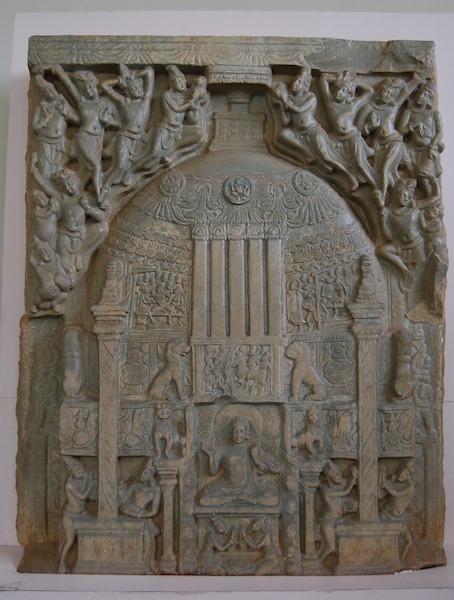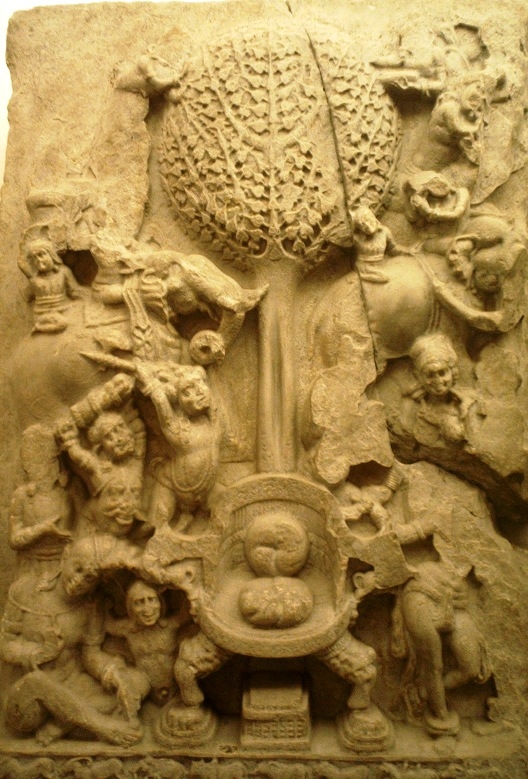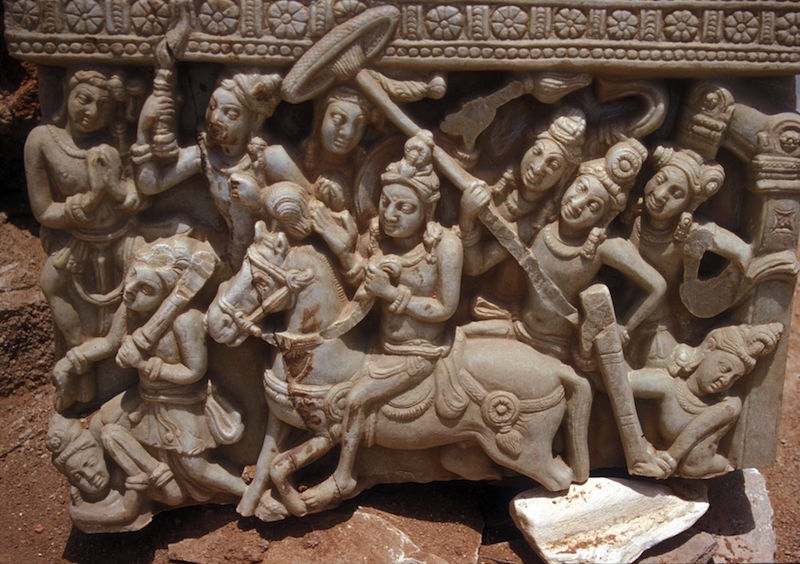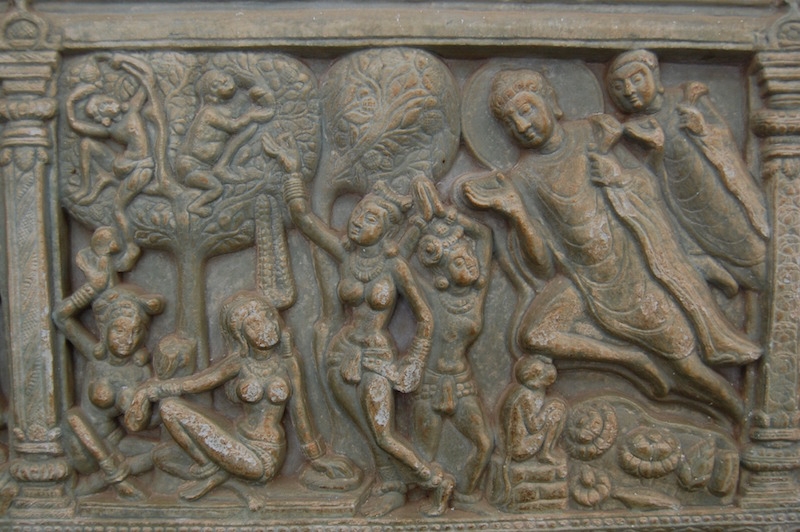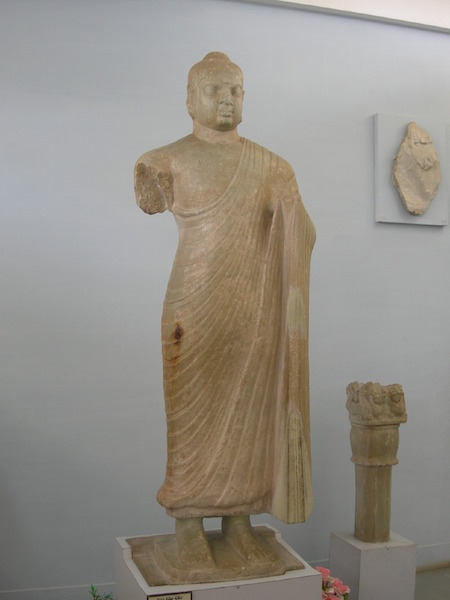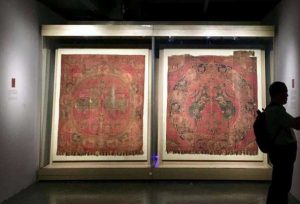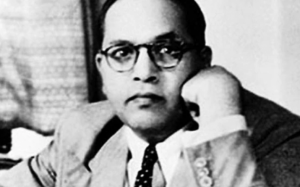The exciting and thought-provoking new book “Shifting Stones, Shaping the Past: Sculpture from the Buddhist Stupas of Andhra Pradesh,” by University of Illinois assistant professor Catherine Becker, divides conveniently into two sections, the first part examining the major early Buddhist remains in Andhra Pradesh and the second focusing on the social context of newly built Buddhist monuments in the state. The modern Indian state of Andhra Pradesh faces the Bay of Bengal, sandwiched between Tamil Nadu to the south and West Bengal to the north. The country’s long coastline never figured into the Buddha’s life story and therefore Andhra Pradesh was never included among the major pilgrimage destinations, such as Bodh Gaya in Bihar or Sarnath in Uttar Pradesh. Nevertheless, Buddhism took firm root in ancient Andhra Pradesh, starting from as early as the 2nd century BCE.
The ancient region of Andhra was ruled by the Satavahana dynasty (c. 3rd century BCE–c. 2nd century CE), in whose vast realm Hinduism and Buddhism coexisted. By the 2nd century, Andhra became home to some of the most impressive Buddhist stone sculpture in all of India, funded in part by its kings and queens, who have left us numerous stone inscriptions. These very same patrons were responsible for the world-famous Great Stupa at Sanchi in Madhya Pradesh, a World Heritage monument. No less impressive than Sanchi was an enormous stupa at the Satavahana center of Amaravati, today a small town bordering the Krishna River near Andhra Pradesh’s coast. Largely in ruins when it was “discovered” by a European, Colonel Colin Mackenzie, in 1797, the stupa’s limestone sculpture is now divided nearly equally between the British Museum and the museum in Chennai. In fact, sculpture from Amaravati and other sites in the region are now in every major museum in the world. New Buddhist sites, complete with monasteries and stupas, are still being discovered in India, such as at Phanigiri in Andhra Pradesh and at Kanaganahalli in Karnataka State, whose excavation started in 1994.
The Amaravati stupa’s original appearance is revealed in a number of large limestone slabs that were once attached to its exterior surface. The shape and ornamentation are reminiscent of the Sanchi stupa but with some special regional characteristics, notably the five prominent pillars placed above each of the entrance ways. These slabs frequently depict devotees paying homage to the stupa in various ways. Do these figures represent well-known Buddhist myths, such as Sujata offering the Buddha food at Bodh Gaya, or should these activities be interpreted as real or idealized devotion for ancient viewers’ emulation? The answers to these questions go right to the heart of what the artists and patrons intended, and the author grapples with the pros and cons of the various modern explanations.
As elsewhere, the earliest sculpture in Andhra eschewed the portrayal of the Buddha, preferring to indicate the Master’s presence with symbols, such as his footprints. An excellent example from the stupa at Ghantasala shows the Assault of the Demon Mara, his army attacking an empty throne, designed to represent the Buddha himself. Later, artists depicted the Buddha freely and routinely, showing various episodes in the Buddha’s life drawn from a variety of literary sources. A popular theme was the Buddha’s departure from the palace, where he is shown astride his horse.
One very useful focus of the book is the treatment of the textual sources for the sculptures. One example is the conversion of the Buddha’s half-brother, Nanda. The story of Nanda is found in the Buddhist canon but was greatly popularized by the Indian philosopher-poet Ashvaghosha’s (c. 80–c. 150) Sanskrit Saundarananda, or The Handsome Nanda. This beloved tale begins with Nanda visiting the Buddha after his recent marriage to a wife of incomparable beauty. The Buddha, however, convinces Nanda to take the tonsure; once shorn, he of course can no longer return to his wife. But Nanda regrets his decision immediately and starts to pine for sensual gratification. To stiffen his resolve, the Buddha cleverly presents Nanda with an ugly old female monkey. Nanda is asked to declare who is more beautiful, his wife or this monkey! He naturally replies that his wife is the more beautiful. The Buddha then escorts Nanda to Indra’s Heaven, where he witnesses numerous nymphs who greatly exceed even the beauty of his wife. The Buddha promises Nanda that if he remains a monk, then such a harem will await him once he has mastered the ways of the Dharma. But the Buddha’s sage disciple, Ananda, gently rebukes the misguided Nanda, pointing out to him the absurdity of sticking to celibacy “for the sake of sex” (p. 11). Nanda instantly realizes his folly, almost reminiscent of the Zen experience of satori, prompted by a koan, and eventually attains arhatship. In a stone carving from the stupa at the site of Nagarjunakonda, the ancient sculptor has captured that very moment when the Buddha and his companion, Nanda, fly through the air, glimpsing the tiny monkey and contrasting it with the heavenly damsels nearby.
The Andhra artists also produced sculptures of the Buddha conceived completely in the round, shown standing with one arm raised and holding the hem of his long robe, and the other raised in abhaya mudra, or the gesture of reassurance. This type of depiction is thought to have greatly influenced early representations of the Buddha in Sri Lanka and certain parts of Southeast Asia.
The second half of the book reflects a relatively new scholarly trend which examines the role of hallowed cultural symbols from the past in contemporary societies. Although the population of Andhra Pradesh is largely Hindu, the public and private sectors have dipped into its old Buddhist roots to seek symbols which express solidarity with its ancient past. One chapter chronicles the creation of a gigantic white granite standing image of the Buddha, erected on a small island in Hyderabad’s Hussain Sagar Lake in 1992. Its inception was inspired by Andhra Pradesh’s chief minister, who visited the USA in 1984 and was impressed by the Statue of Liberty in New York’s harbor. Another chapter details an enormous pageant held in Andhra in 2006 to celebrate the Fourteenth Dalai Lama’s 30th enactment of a Kalachakra Initiation. Since the total number of Buddhists in India is so small, political parties and civic leaders popularizing Buddhist festivals or erecting Buddhist memorials cannot be accused of favoring one or the other of the far larger Hindu or Muslim populations. It was likely for this reason that India’s national seal, adopted in 1947, was modeled on the 24-spoke Wheel of the Law found on the famous Buddhist column erected at Sarnath in Emperor Ashoka’s (r. c. 269 BCE–c. 232 BCE) time. A purely Hindu symbol would have been inflammatory to India’s large Muslim community.
The history of Buddhism is a tale of numerous paradoxes, but perhaps the greatest is the inexorable decline the faith has experienced in its homeland and its blossoming outside India’s borders, chiefly in East and Southeast Asia. Buddhism will never return to its former popularity in India, but the ancient and modern history of Andhra Pradesh, so proficiently recounted in this new book, assures us that Buddhism will never be forgotten.
Shifting Stones, Shaping the Past: Sculpture from the Buddhist Stupas of Andhra Pradesh was published by Oxford University Press in 2015.
After receiving his PhD in Indian art from the University of California, Berkeley, Donald M. Stadtner was for many years an associate professor at the University of Texas, Austin. He is the author of Ancient Pagan(2005) and Sacred Sites of Burma (2011), and co-author of Buddhist Art of Myanmar, An Exhibition Catalogue, Asia Society, New York (2015). He divides his time between the San Francisco Bay Area and research trips to Southeast Asia and India.
